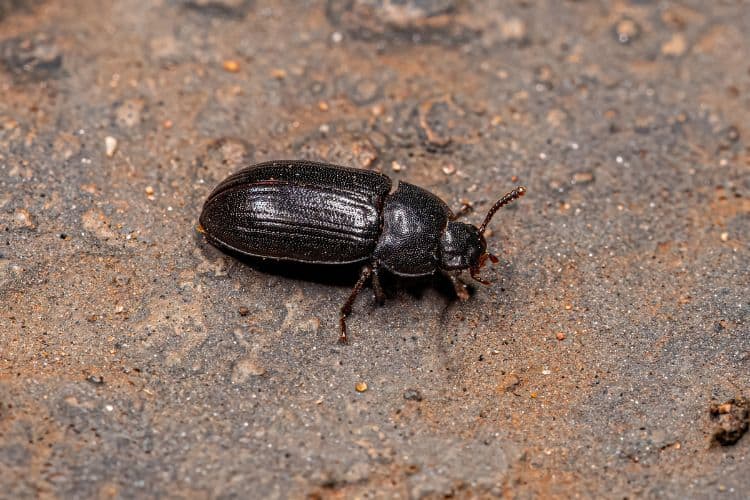Leopard geckos are captivating companions with their dazzling patterns and gentle demeanors. Yet, ensuring their dietary needs can be a balancing act.
Enter darkling beetles, a diverse group encompassing mealworms and superworms – readily available options that pique the gecko’s curiosity. But can these beetles truly join the gecko’s dinner party? Can leopard geckos eat darkling beetles?
The answer, like many things in nature, isn’t black and white. Let’s explore the fascinating world of darkling beetles, and check their suitability as treats for your beloved leopard gecko.
What exactly Are Darkling Beetles?
Darkling beetles are a family of insects called Tenebrionidae. Here are some key facts about them:
- There are over 20,000 species of darkling beetles worldwide. Some well-known types include the mealworm beetle and the lesser mealworm.
- They tend to live in dry, dark habitats like under rocks, inside decaying wood, and dry vegetation.
- Darkling beetles are nocturnal and cannot fly. They move quite slowly.
- In terms of appearance, they have elongated flattish bodies and short antennae. Their bodies are typically black or dark brown.
- They can range in size from just a few millimeters to over an inch long depending on the exact species. Common pet food species are generally 0.5 – 1 inch long.
- Darkling beetles and their larvae are high in protein, fat, and nutrients like zinc, making them suitable as feeder insects. Mealworms are commonly fed to reptiles and birds.
- Their hard outer shells make them more difficult for some animals to digest compared to soft-bodied insects like crickets. This can pose an impaction risk for small reptiles if not fed properly.

So, Can Leopard Geckos Eat Darkling Beetles?
Yes, they can, but with caution. While not inherently toxic, darkling beetles present some potential downsides for leopard geckos.
Darkling beetles are generally safe for leopard geckos to eat in moderation. They are not poisonous and do not carry harmful parasites or bacteria when properly cared for.
Some darkling beetle species, like superworms, are even used as staple feeder insects for certain reptile species due to their high protein content.
Types of Darkling Beetles Suitable for Geckos
- Superworms (Zophobas morio): Larger than mealworms, offering more protein and fat, but have a harder exoskeleton that can be challenging for smaller geckos.
- Lesser mealworms (Alphitobius diaperinus): Smaller and softer than superworms, easier to digest but lower in protein.
- Black soldier fly larvae (Hermetia illucens): Highly nutritious option with a soft exoskeleton, but not as readily available as mealworms.
Reasons for Caution
- Harder exoskeleton: The exoskeleton of darkling beetles, particularly superworms, is tougher than that of crickets or other common feeder insects. This can make digestion difficult for some geckos, leading to impaction or constipation.
- Lower nutritional value: Compared to crickets, darkling beetles generally have lower
calcium and vitamin D3 levels, essential nutrients for geckos. This necessitates gut-loading (feeding nutritious food to the beetles before offering them to the gecko) and supplementing the gecko’s diet withcalcium and vitamin D3. - Risk of injury: Darkling beetles can bite, and their hard exoskeletons can cause minor injuries to geckos. Additionally, superworm adult beetles can burrow, potentially escaping the enclosure, and posing a choking hazard if ingested by the gecko.
Feeding Darkling Beetles to Leopard Geckos
Every gecko is different. Adjust the feeding frequency, size, and type of darkling beetles based on your individual gecko’s needs and preferences. Consulting a qualified reptile veterinarian is always recommended for personalized advice on your gecko’s diet and care.
Preparation
- Gut-loading: 24-48 hours before feeding, gut-load the beetles with nutritious foods like chopped fruits (apples, carrots), vegetables (sweet potato, squash), or commercial gut-loading formula. This enhances the meal’s nutritional value for your gecko.
- Size: Choose beetles appropriate for your gecko’s size. Young geckos can choke on larger ones, while adults might struggle with small ones. As a rule of thumb, the beetle should be no wider than the space between your gecko’s eyes.
- Cleaning: Gently remove any bedding debris or frass from the beetles before offering them to your gecko. Also, try to store mealworms properly to avoid contamination or rotting.

Feeding
- Controlled environment: Feed the beetles in a separate container within the gecko’s enclosure. This prevents escape and allows easy monitoring.
- Offer the beetles: Use tweezers to gently place the beetles in front of your gecko.
- Supervision: Observe your gecko during feeding. Ensure it catches and consumes the beetles without difficulty.
- Removal: Remove any uneaten beetles after 10-15 minutes to prevent them from escaping or harming the gecko.
Frequency and Additional Tips
- Use as a snack: Offer darkling beetles as an occasional treat, not a staple food. 2-3 times a month is a good guideline, depending on your gecko’s age and dietary needs. The same rule applies to wax worms and similar treats.
- Variety: Mix up their diet with other feeder insects like crickets and dubia roaches for a balanced nutrient intake.
- Calcium dust: Consider lightly dusting the beetles with
calcium powder without D3 to supplement theircalcium intake. Consult your vet for appropriate dusting frequency. - Hydration: Ensure your gecko has access to clean, fresh water at all times.
- Monitor: After feeding, observe your gecko for signs of impaction or other digestive issues. Consult your vet if you have any concerns.
Conclusion
While darkling beetles like mealworms and superworms can offer occasional variety in a leopard gecko’s diet, moderation is key. Their tough exoskeletons and lower nutritional value necessitate cautious inclusion.
By prioritizing gut-loading, offering the appropriate size, and monitoring closely, you can ensure your gecko enjoys these treats safely.
Remember, a balanced diet with diverse feeder insects remains paramount for optimal health.

